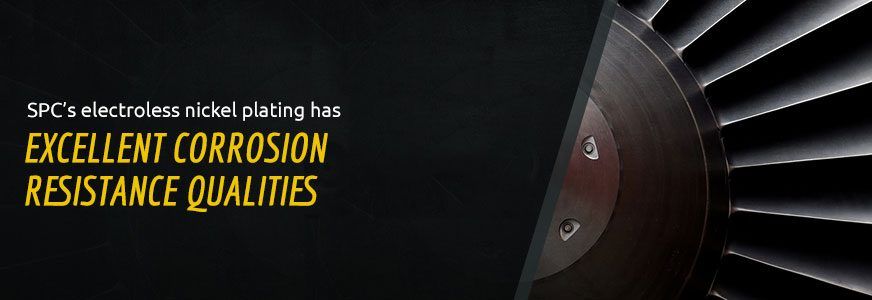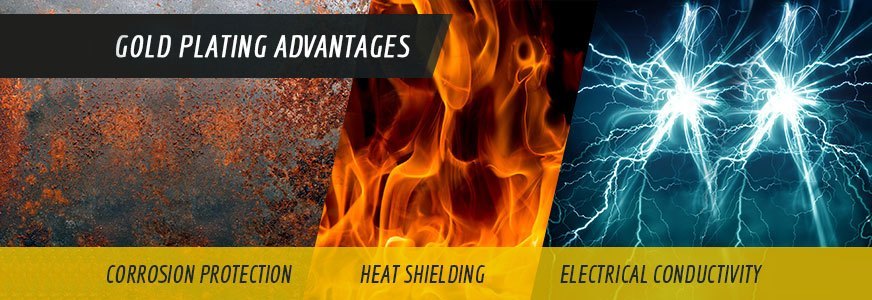
Plating for the Optics Industry
The process of optical coating is, in essence, the addition of one or more layers of material onto an optical component, such as a lens or mirror. This coating can fundamentally alter the way in which this optical component reflects and transmits light, but it can be used for other purposes as well, such as protection or structural support. In these latter cases, the coating is most commonly a metal, in which case the coating process can be called optical plating.
Optical plating services are crucial to the manufacturing of optical instruments and are important for a number of industrial and scientific fields. Not only does this mean optical parts are in high demand now, but it means they will continue to be in high demand in the future. Indeed, the global demand for optical coatings is valued at about $6.5 billion annually and is expected to continue growing by 6.5 percent every year.
In order to understand the applications and options available with optics plating, we've outlined some of the key features and benefits of this particular process, the materials available and what you should expect from a quality optics plating service.

The Purpose of Optics Plating
The process of optics plating is extremely precise and results in the application of a specialized metal coating to the base material. This metal coating serves the following purposes within the finished optical device:
- Protection against corrosion: Plating is most often used as a form of protection against the elements. Between atmospheric chemicals, weather conditions and other factors, numerous conditions can start to eat away at the optical material. For example, aerospace technology often flies in and out of earth's atmosphere, undergoing a great deal of heat stress and atmospheric elements. If unprotected, optical equipment within those machines may not hold up to these stresses for long before breaking, rendering them useless and potentially endangering the project and its crew. Plating helps to avoid this as much as possible by offering additional corrosion protection to optical equipment.
- Increasing surface hardness: In addition to providing more corrosion resistance to the optical material, plating also lends a great deal of structural support. While the optical material itself may be fragile under pressure or if met with an impact, metal coating is much more resistant to such forces. Applying a metal coating to the exterior of a piece of optical equipment not only provides improved structural integrity, but it also increases the overall longevity of the piece of equipment.
- Enhancing lubricity: Many pieces of optical equipment will be used within other components. However, normal use of such equipment can cause vibrations or movement between the optical piece and its neighbors, resulting in friction. While normal, this can result in problems, such as the pieces grinding against one another, incurring damage or even chipping. In order to avoid this, a metal coating may be applied to the exterior of the optical piece to improve lubricity and reduce friction between the optical piece and its neighbors. This protects both pieces from long-term wear.
- Altering optical properties: Finally, and arguably most importantly, is the fact that the application of plating to an optical piece can change the optical properties of the piece. Mirrors, for example, are created by applying a reflective metal coat to the back of a piece of glass. Similarly, coating the exterior portion of a lens with metal can alter the way it behaves. This, again, depends on the particular application in question.
Additional purposes of optical coatings can vary widely depending on the industry the optical piece is being used in. However, nearly every industry benefits from the above listed qualities of optical plating.

Applications for Optics Plating
The worldwide optics industry manufactures a vast range of optical parts. At their most basic, these optical parts primarily include the following:
- Lenses: These curved portions of transparent material are designed to bend light in a specific way and are used in applications across industries, from microscopes to telescopes and beyond.
- Lenticular rolls: Also known as lenticular lenses, these are cylindrical lenses arranged next to one another into what looks like adjacent bumps or rolls. These are often used for projects where different magnification is needed at different angles.
These parts, once completed, can be used in a huge array of industries relating to optics. These industries include, but are not limited to:
- Aerospace technology: Telescopes and advanced optical technology are extremely important for space exploration and observation. From the Hubble telescope to the Mars rover Curiosity, high-performance lenses are needed to take pictures and transmit images of the furthest reaches of space and send them home for aerospace scientists to study. Additionally, aerospace technology is extremely susceptible to atmospheric corrosion, which is why optical coatings are so important to the structural integrity and longevity of aerospace projects.
- Biomedical technology: Demand for optical coatings has increased drastically in the medical field, experiencing an average 6 percent global growth each year. Advanced fiber optics and other imaging software is increasingly needed within the medical field for new, less invasive procedures and checkups. Now, many surgeries are completed laparoscopically, with the administration of a few incisions, fiber optic laparoscopes and precision surgical equipment. Not only does this reduce patient discomfort and minimizes the risk of complications, but it also speeds up the recovery process and makes possible more exploratory and preventative surgeries. Today, over 71 percent of appendectomies, 28 percent of colectomies and 13 percent of hysterectomies use a laparoscopic surgical procedure.
- Military technology: Defending all that we hold dear is a noble and crucial part of military operations. In order to succeed in this important role, the military has to be at the pinnacle of technological prowess and must continuously improve. Much of this relies on quality optics. From laser applications to surveillance technology, the development and use of high-quality optical parts are crucial to the effectiveness of the military.
- Laser technology: An industry in itself, laser technology has taken the world by storm in recent years, with industries and applications so varied it's impossible to pigeonhole them. In 2016 alone, laser sales have experienced over 4 percent growth. From simple cat toys to surgical equipment to manufacturing tools and military technology, lasers are here to stay and they need quality lenses to focus their beams.

For any of these applications, the needs of the industry are paramount and can lend to some notable differences in needs. To this end, companies seeking optics plating services should seek out a reliable, cost-effective service with the ability to customize their services to your specific manufacturing requirements. Part of this specialization involves offering a variety of materials for optical plating.
Materials for Optics Plating
In order to serve optical companies, quality optical plating services offer numerous plating options, with a variety of metals available for plating. Sharretts Plating Company is no exception: We offer both electroless nickel plating and gold plating services.
Request a free quote
For Optics Plating
Optical Grade Electroless Nickel Plating
Electroless nickel plating is a process opposite to electroplating. In this process, electricity is not introduced into a plating bath in order to plate the material. Instead, the coating process is accomplished with a chemical reaction.
For optics, Sharretts Plating Company, or SPC, uses a high-phosphorous, high-build nickel coating. This coating, designed specifically for optics industry applications, results in a uniform deposit thickness. Even better, the application is more consistent, able to cover the most hard-to-reach surface areas without building up along the edges.
Other benefits of this particular electroless plating process include the following:
- Excellent corrosion resistance qualities: The resistance of electroless nickel to corrosion makes it a highly sought-after coating within the aerospace industry. Not only does nickel offer protection to the optical equipment it is applied to, but it can maintain that protection for long periods of time without wearing down or compromising the integrity of the piece.
- Maintains impressive hardness: While not the hardest material available on the market, nickel does have the benefit of offering improved hardness to any equipment it is applied to. This additional structural support means improved resistance to damage and lends to the overall longevity of the equipment.
- Performs well on ferrous and non-ferrous metal surfaces: Despite the substrate, SPC's process will work well on the equipment in question. Many applications require a ferrous metal coating before the nickel layer, which can be problematic for many optical plating services.
- Capable of holding extremely tight tolerances: Electroless nickel can be deposited onto a surface with extreme accuracy and precision, with the layer remaining completely even across the entire surface of the piece. This is critical for applications where the tolerances are extremely tight, such as military and aerospace applications.
- Less void volume than traditional electroless nickel coatings: Void volume refers to the volume of the voids between particles or gaps in a layer of plating. These gaps can be extremely problematic, as they leave room for corrosion to take hold or can compromise the structural integrity of the layer. In SPC's method, voids are minimized, protecting the structural integrity of the finished product and minimizing the possibility for corrosion.
- Can be deposited to thicknesses greater than 0.015 inches: Many industries need outer layers that are relatively thick compared to other plating applications. This is primarily due to the structural and corrosion needs of optical applications. While less developed methods prevent this thick deposition of material due to the possibility of imperfections, SPC has perfected their method to support even thick applications of electroless nickel, simplifying and expediting the plating process.
These incredible qualities make SPC's unique electroless nickel plating method one of the most sophisticated methods in the industry.

Optical Grade Gold Plating
Gold optical plating is a specialty type of optical plating, and it is often used to coat extremely specialized parts, such as the connectors and tips of fiber optics cables. Gold-plated connectors in particular are extremely unique within the world of fiber optics and offer some very important benefits to this particular application. For example, the gold plating of fiber optic tips promotes signal transfer, maximizing transfer capabilities within fiber optic cables.
When applied to the majority of optical applications, optical grade gold plating offers several key benefits. These include incredible durability, environmental durability and increased flexibility. Some of the other benefits of plating optics products with gold include easy masking for selective surface applications and high reflectivity, which can be extremely helpful for protecting against heat. Additionally, optical gold plating is largely recognized as an alternative to evaporating overcoats, the latter of which is a much more expensive process than gold plating.
In addition to electroless nickel plating, SPC has developed the best optical gold plating process in the industry, able to be applied to nearly any optics applications. In addition to the numerous benefits of gold by itself, our unique process can provide several additional advantages, including the following:
- Corrosion protection: Like nickel, gold is widely recognized as an impressively corrosion-resistant material, and it is often used as a protective layer for more corrosion-prone materials, like copper. This corrosion resistance is improved upon by SPC's impressive plating process, which further reduces the likelihood of corrosion and improves the coverage of the gold plating in order to protect the substrate more effectively.
- Additional heat shielding: Gold also happens to be an excellent heat shield. Used across numerous industries as a protective heat shield for electronics and other delicate materials, gold can similarly be used to provide thermal protection for optical applications. This is extremely important for applications where the optics may be used in situations with extreme heat, such as military or aerospace applications.
- Improved electrical conductivity: In addition to the above traits, gold is also an extremely conductive material, on par with copper as an excellent electrical conductor. Used often as a covering for electrical equipment and circuit boards, gold is recognized across several industries as an effective conductor. This quality is promoted further with SPC's industry-leading gold plating process.
These qualities and more make SPC a leader in gold plating for optical applications!

Optical Plating Solutions
If you are looking for a plating company with the skill and expertise needed to properly handle the delicate nature of optics projects, SPC may be the right choice for you.
SPC is a leader in innovative plating and metal finishing solutions, offering top-of-the-line service for a wide range of companies and industries since 1925. We handle optical coating differently — unlike many optical coating companies, we pride ourselves on custom service, taking the extra time to get to know our customers and their needs before tackling a project.
This consultative approach means we focus on you and your company first and we run the extra mile to ensure your satisfaction. This may include a simple discussion in person or on the phone, or it can include performing an on-site assessment of your company. We want to gain a complete understanding of your company's unique manufacturing processes so we can ensure your satisfaction in our services. Additionally, we focus very strongly on process development and can ensure high-quality results while simultaneously lowering your operating costs.
Contact Sharretts Plating Company
Learn more about the many ways SPC's incredible optics plating services can benefit your company. Contact us today for more information! If you like what you hear, we'd be happy to provide you with a no-obligation optical coating price quote!
LEARN WHAT OUR MANY SATISFIED CUSTOMERS HAVE TO SAY ABOUT Us
"I would like to thank you for the help you have provided us in developing an electroless nickel plating technique on an unusual substrate. The sample platings you provided show that we should be able to reach our goals. I especially appreciate your willingness to take on an unusual job, with the uncertainties that that entails...We are looking forward to working with you in the future on our plating needs."
– Robert K.



